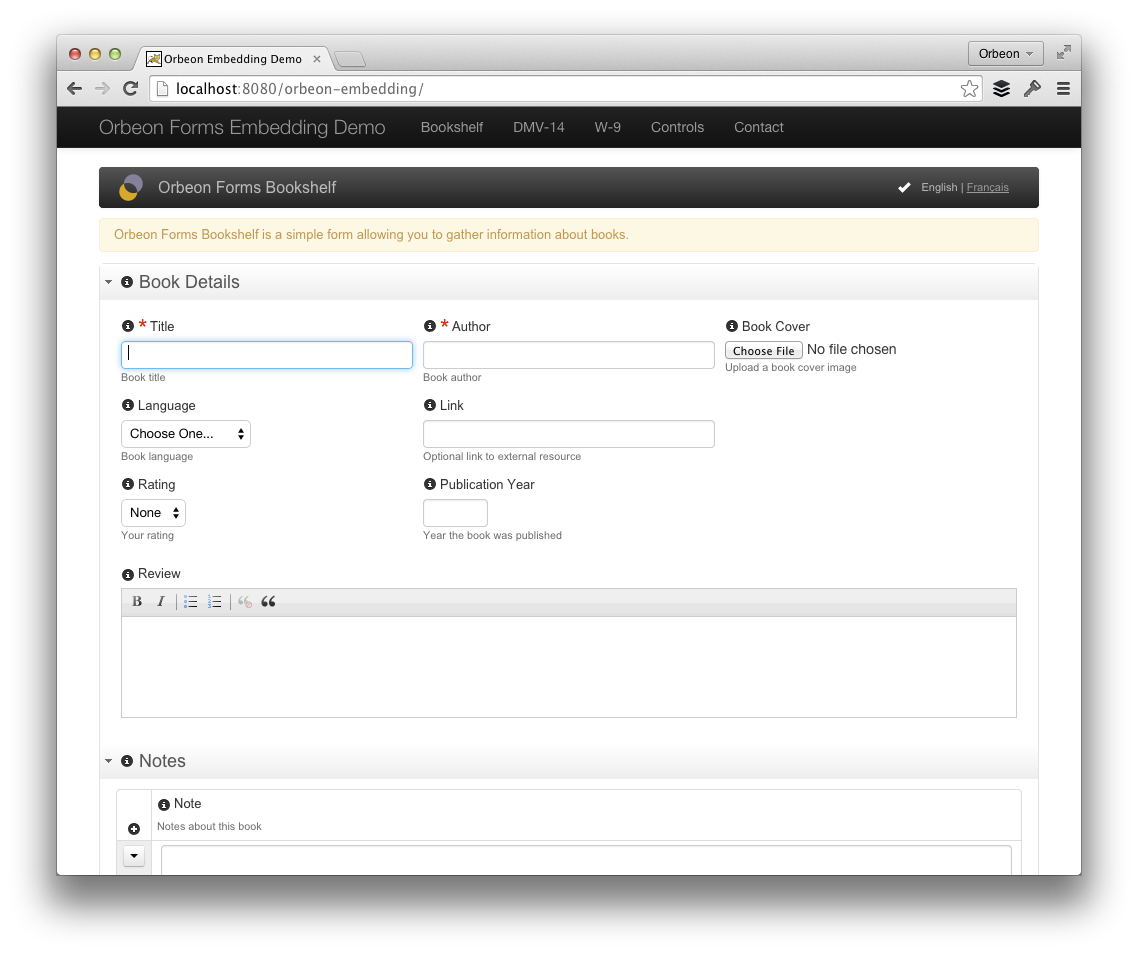-
Notifications
You must be signed in to change notification settings - Fork 221
Form Runner ~ APIs ~ Server Side Embedding
Home ▸ Form Runner ▸ APIs
Since Orbeon Forms 4.7.
The intent is to allow Java (and other Java Virtual Machine (JVM)-based languages) applications to easily embed forms produced with Form Builder within other pages.

Your own web app does the following:
- include
orbeon-embedding.jarunderWEB-INF/lib - setup a filter in
WEB-INF/lib - call the embedding API when producing a page
This is a typical filter configuration:
<!-- Declare and configure the embedding filter -->
<filter>
<filter-name>orbeon-form-runner-filter</filter-name>
<filter-class>org.orbeon.oxf.fr.embedding.servlet.ServletFilter</filter-class>
<init-param>
<param-name>form-runner-url</param-name>
<param-value>http://localhost:8080/orbeon</param-value>
</init-param>
<init-param>
<param-name>orbeon-prefix</param-name>
<param-value>/orbeon</param-value>
</init-param>
</filter>
<!-- Any JSP resource is processed by the filter -->
<filter-mapping>
<filter-name>orbeon-form-runner-filter</filter-name>
<url-pattern>*.jsp</url-pattern>
<dispatcher>REQUEST</dispatcher>
<dispatcher>FORWARD</dispatcher>
</filter-mapping>
<!-- This ensures that Orbeon resources are proxied appropriately -->
<filter-mapping>
<filter-name>orbeon-form-runner-filter</filter-name>
<url-pattern>/orbeon/*</url-pattern>
<dispatcher>REQUEST</dispatcher>
<dispatcher>FORWARD</dispatcher>
</filter-mapping>And here is an example of embedding a form from a JSP page:
<%@ page
pageEncoding="utf-8"
contentType="text/html; charset=UTF-8"
import="org.orbeon.oxf.fr.embedding.servlet.API" %>
<!DOCTYPE HTML>
<html>
<body>
<%
API.embedFormJava(
request, // HttpServletRequest: incoming HttpServletRequest
out, // Writer: where the embedded form is written
"orbeon", // String: Form Runner form name
"bookshelf", // String: Form Runner app name
"new", // String: Form Runner action name
null, // String: Form Runner document id (optional)
null, // String: query string (optional)
null // Map<String, String>: custom HTTP headers (optional)
);
%>
</body>
</html>You deploy Form Runner in a separate web app, which can be located in the same servlet container as your web app or in a separate or even remote servlet container.
Form runner must use "combined resources" to work. This is the case by default in prod mode (see Run Modes), but if you happen to have setup Orbeon Forms in dev mode, make sure to add this property in your properties-local.xml:
<property
as="xs:boolean"
name="oxf.xforms.combine-resources"
value="true"/>The embedding JAR uses SLF4J for logging. If your application already uses SLF4J and already has slf4j-api.jar, you can remove the one provided by Orbeon under WEB-INF/lib. Otherwise, you must keep slf4j-api.jar in your application's WEB-INF/lib folder.
OPTIONAL: In addition, if you want to actually configure logging for the embedding library, you must add a logging adapter for SLF4j and the appropriate configuration file, for example for log4j. See the sample configuration file under WEB-INF/classes/log4j.properties.template.
The embedding implementation communicates with the rest of Orbeon Forms via HTTP or HTTPS. In general, you probably won't have to change this configuration. By default, it is as follows:
<init-param>
<param-name>oxf.http.stale-checking-enabled</param-name>
<param-value>true</param-value>
</init-param>
<init-param>
<param-name>oxf.http.so-timeout</param-name>
<param-value>0</param-value>
</init-param>
<init-param>
<param-name>oxf.http.chunk-requests</param-name>
<param-value>false</param-value>
</init-param>
<init-param>
<param-name>oxf.http.proxy.host</param-name>
<param-value/>
</init-param>
<init-param>
<param-name>oxf.http.proxy.port</param-name>
<param-value/>
</init-param>
<init-param>
<param-name>oxf.http.proxy.exclude</param-name>
<param-value/>
</init-param>
<init-param>
<param-name>oxf.http.ssl.hostname-verifier</param-name>
<param-value>strict</param-value>
</init-param>
<init-param>
<param-name>oxf.http.ssl.keystore.uri</param-name>
<param-value/>
</init-param>
<init-param>
<param-name>oxf.http.ssl.keystore.password</param-name>
<param-value/>
</init-param>
<init-param>
<param-name>oxf.http.proxy.use-ssl</param-name>
<param-value>false</param-value>
</init-param>
<init-param>
<param-name>oxf.http.proxy.username</param-name>
<param-value/>
</init-param>
<init-param>
<param-name>oxf.http.proxy.password</param-name>
<param-value/>
</init-param>
<init-param>
<param-name>oxf.http.proxy.ntlm.host</param-name>
<param-value/>
</init-param>
<init-param>
<param-name>oxf.http.proxy.ntlm.domain</param-name>
<param-value/>
</init-param>Details about the meaning of these parameters are [[available here|Installation--Configuration-Properties--General-Properties#http-client]].
You can enable HTTP gzip compression between the embedding implementation and Form Runner. For example, with Tomcat:
<Connector
port="8080"
protocol="HTTP/1.1"
connectionTimeout="20000"
compression="force"
compressableMimeType="
text/html,
text/xml,
text/plain,
text/css,
text/javascript,
text/json,
application/x-javascript,
application/javascript,
application/json"
redirectPort="8443"/>In your Java web application, any page covered by the servlet filter can call the embedding API. You can have a single page calling a single form, or several pages each calling a different form. Or, pages can (based on URL parameters, internal application state, etc.), embed a form dynamically.
As of Orbeon Forms 4.7, the embedded form cannot navigate in place to another form or mode (such as Review).
However, it can save form or send form data as it does in the standalone case. It can also run custom processes which can redirect the entire embedding page with navigate, or run JavaScript functions with navigate(uri = "javascript:alert('Done!')"). This allows communicating with the embedding application.
The embedding implementation:
- makes an HTTP or HTTPs request to Form Runner to retrieve the HTML to embed when you call the API
- appropriately rewrites URLs in the HTML returned by Form Runner
- keeps track of session and other cookies
- proxies requests for resources, Ajax calls and file uploads to Form Runner
- navigation between pages, such as the Form Runner Edit and Review pages, is not supported
- embedding Form Builder is currently not supported
- embedding multiple forms is known to work in some cases, but has known issues so we don't recommend doing this (see #1854)
-
oxf.xforms.combine-resourcesmust be set totrue